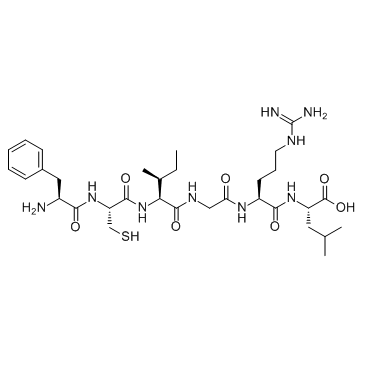AT-1002
Modify Date: 2024-01-12 19:04:54

AT-1002 structure
|
Common Name | AT-1002 | ||
|---|---|---|---|---|
| CAS Number | 835872-35-0 | Molecular Weight | 707.88 | |
| Density | N/A | Boiling Point | N/A | |
| Molecular Formula | C32H53N9O7S | Melting Point | N/A | |
| MSDS | N/A | Flash Point | N/A | |
Use of AT-1002AT-1002, a 6-mer synthetic peptide[1], is a tight junction regulator and absorption enhancer[2]. |
| Name | (2S)-2-[[(2S)-2-[[2-[[(2S,3S)-2-[[(2R)-2-[[(2S)-2-amino-3-phenylpropanoyl]amino]-3-sulfanylpropanoyl]amino]-3-methylpentanoyl]amino]acetyl]amino]-5-(diaminomethylideneamino)pentanoyl]amino]-4-methylpentanoic acid |
|---|---|
| Synonym | More Synonyms |
| Description | AT-1002, a 6-mer synthetic peptide[1], is a tight junction regulator and absorption enhancer[2]. |
|---|---|
| Related Catalog | |
| In Vitro | AT-1002 a 6-mer synthetic peptide belongs to an emerging novel class of compounds that reversibly increase paracellular transport of molecules across the epithelial barrier. AT-1002 can undergo Cys-Cys dimerization[1]. Undifferentiated Caco-2 cells are treated with AT-1002 and viability is assessed by measuring cellular ATP content. Treatment with AT-1002 for up to 3 h does not affect cell viability at any concentration. In particular, the viability of Caco-2 cells is not affected by 5 mg/mL AT-1002. AT-1002 reduces cell viability after 24 h at concentrations of 2.5 mg/mL and higher. However, the cells remain viable after 24 h if the cells are washed after exposure to AT-1002 for 3 h indicating that AT-1002 does not irreversibly damage cells[2]. AT-1002 treatment results in 3-fold increase in phosphotyrosine content of zonula occludens-1 (ZO-1)[2]. |
| References |
| Molecular Formula | C32H53N9O7S |
|---|---|
| Molecular Weight | 707.88 |
| Exact Mass | 707.37900 |
| PSA | 326.97000 |
| LogP | 5.07440 |
| AT-1002 |
| L-Leucine,L-phenylalanyl-L-cysteinyl-L-isoleucylglycyl-L-arginyl |

